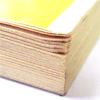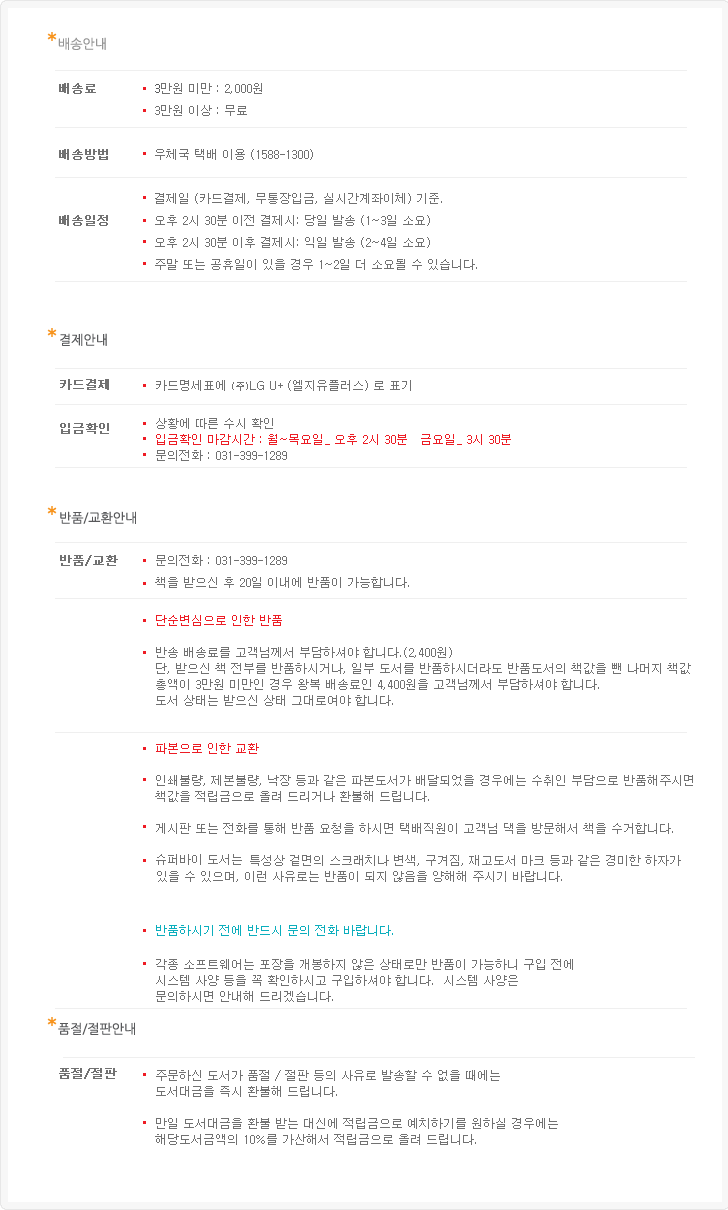|
|
|
|
|
|
|

| 최근 이 책을 구매하신 다른 회원의 책장 |
|
 |
|
|
|
[ 책 소개 ]
그림 형제의 독일 전래동화인 룸펠슈틸츠킨의 이야기를 현실성 있게 재구성한 책입니다.
방앗간집 주인은 자기 딸이 왜 밀집을 금으로 만들 수 있다고 허풍을 떨었는지, 왕은 왜 방앗간 주인의 말을 믿었는지, 난장이 마술사는 왜 방앗간집 딸과 금과 아기를 교환하는 약속을 했는지 등등등... 터무니 없어 보이는 이야기의 속내를 하나하나 분석해서 원본 이상의 재미를 선사합니다.
| 닫기x |  What is 페이퍼백? What is 페이퍼백?
표지가 두꺼운 판지나 보드지가 아닌 비교적 얇은 종이를 사용해서 만든 책이며, 실박음질 대신에 풀로 제본처리하는 경우가 많습니다. 일반적으로 하드커버나 보드북에 비해서 가격이 저렴합니다. 소프트커버로 불리우기도 합니다. 책의 이음새 부분이 접히거나 휘는 내구성이 그리 좋지는 않은 책입니다.
|
[ 서지 정보 ]
Paperback: 128 pages
ISBN-10: 0439305292
ISBN-13: 978-0439305297
책 크기: 19.2cm x 13.2cm
[ 영문 서평 ]
Book Description
Have you ever wondered just what was going on when that odd little man with the long name stepped up and volunteered to spin straw into gold for the miller's daughter? When you stop to think about it, there are some very peculiar, not to mention hard to explain, aspects to that story.
Vivian Vande Velde has wondered too, and she's come up with these six "alternative" versions of the old legend. A bevy of "miller's daughters" confronts the perilous situation in ways that are sometimes comic, sometimes scary. Usually, it's the daughter who gets off safely. Other times -- amazingly -- it is Rumpelstiltskin himself who wins the day, and in one tale, it is the king who cleverly escapes a quite unexpected fate.
Once you've read The Rumpelstiltskin Problem, you may never think about fairy tales in the same way again.
Publishers Weekly
The eponymous problem, as Vande Velde (There's a Dead Person Following My Sister Around) explains in an author's note, is that the original fairy tale "makes no sense." Hence, she retells the classic story six times, creatively changing elements with each variant. What results is a charming and clever collection that explains such conundrums as: Why, if the daughter can spin straw into gold, is the miller so poor? What would an elf want with a baby? Vande Velde keeps the basic structure the same: always a miller's daughter must spin straw into gold for the king, always the claim is made that Rumpelstiltskin does it for her--or at least teaches her--in exchange for her firstborn--and ultimately someone must guess the creature's strange name to break that contract. In one scenario, "The Domovoi," Rumpelstiltskin is a magical, teddy bear-like creature living under the castle basement; in "Ms. Rumpelstiltskin," the titular character takes the form of an ugly and lonely witch. The miller's daughter may fall in love with the king, or with Rumpelstiltskin, and once she runs off without falling in love at all. In the closing, particularly funny version, the miller's manipulative daughter named Carleen tries to bully kindly King Gregory into marrying her. Though the opening lines feel forced (one begins, "Once upon a time, before pizzerias or Taco Bells"), Vande Velde's takes on this fairy tale are always humorous and often heartwarming.
Children's Literature
In an engaging, witty author's note, the author questions the sense and logic of the original Rumpelstiltskin story, then goes on to answer some of her own questions by creating six new versions that confront aspects of the story in wildly various, humorous ways. The new stories are told from a variety of perspectives¾a troll named Rumpelstiltskin wonders what a human baby would taste like; a kind-hearted king, Gregory, must outwit a greedy, bad-tempered miller's daughter in order to get his peaceful life back. One of the most fascinating features of this new collection is the way the author turns around and alters preconceived ideas about feelings and motives, and even the identities of the villain and the good guys. The lively, humorous dialogue makes this book especially good for reading aloud. Besides just being fun, these stories might inspire young writers to try similar revisions of old tales.
School Library Journal
The problem is, as Vande Velde explains in her introductory note, that the story of Rumpelstiltskin just doesn't make sense. What kind of king would believe that the miller's daughter could spin straw into gold and still be as poor as she appeared? What kind of girl would want to marry a king who had just threatened to behead her? The author considers these inconsistencies and more and offers six new versions of the story that present other possibilities and other viewpoints. In one, a taste for human baby flesh motivates Rumpelstiltskin's bargain; in another, he is a tall and handsome elf who brings gold from his parallel world. These short variations on the story have a sly humor and a contemporary feeling, even within the fairy-tale setting, but ultimately require the same willing suspension of disbelief as the original. This is an interesting experiment that will appeal most to fairy-tale fans who just can't get enough of the traditional genre.
Kirkus Reviews
Of making many books there is no end, and of making many fairy tales with alternate settings, characters, or perspectives there clearly is no end in sight. Vande Velde (Magic Can Be Murder, p. 1366, etc.) extends this popular subgenre into the upper-elementary through junior-high level, with her collection of six short stories on a Rumpelstiltskin theme. She begins in an introduction by examining the logical fallacies inherent in the traditional versions of "Rumpelstiltskin," detailed in a slightly sarcastic style that will appeal to junior-high students. Each of her short stories then addresses one of these problems in various clever ways. The first three stories deal with the motivation of the Rumpelstiltskin character. In the first, Rumpelstiltskin is a mean troll who wants to eat a baby for lunch; in the second, he is a helpful, gentle elf who eventually rescues the miller's daughter and her baby from an uncaring king; and in the third, Rumplestiltskin is a domovoi, a furry Russian creature who lives under the floorboards of the castle, simply trying to keep all the humans happy. The following three stories have human characters taking on the role of Rumpelstiltskin within the story structure. The father solves the gold-spinning problem himself in one story, and the exemplary king rids himself of a greedy, conniving miller's daughter in another. In Ms. Rumpelstiltskin, the main character is a neighbor of the miller and his daughter, an unpleasant witch-like woman who wants a daughter of her own to raise (in a locked tower, as it turns out). Although the stories are rather a bit much to read all at once, separately they are both clever innovations on the traditional tale andusefulinstructionally in analyzing motivation and character. Teachers who use fairy tales in the classroom will find this an effective and amusing collection, with just the right amount of snappy sarcasm to snag the junior-high set. Young readers who like Robin McKinley's fairy-tale retellings will also enjoy this collection. |
|
|
|
|
 |
제품상제정보 배송/반품/교환 안내 |
|
|
|
Super Buy 도서는 미국 출판사의 재고도서(Remainder Book), 초과출간도서(Excess Inventory), 할인도서(Bargain Books)
등을 직수입해서 정가의 55%~80%를 할인한 가격에 판매하는 제품입니다.
Super Buy 책의 품질은 거의 새 책과 같은
수준이지만, 간혹 커버의 스크래치나 접힘과 같은 하자나, 책 하단의 재고도서 마크가 있을 수 있습니다.
저렴하게 판매하는 Super Buy 제품의 특성상 반품이 되지 않습니다만, 파본인 경우에는 착불로 반품하시면 책값을
환불해드리거나 적립금으로 올려드립니다. (반품 전에 연락 요망)
하프프라이스북에서는 중고도서(second hand book)를 취급하지 않습니다.
|
|
|
 - 등록된 128,139건의 서평이 있습니다. - 등록된 128,139건의 서평이 있습니다.
| 더보기 
|
|
|
|
|
|
|
 |
|
|
|
|
|
|